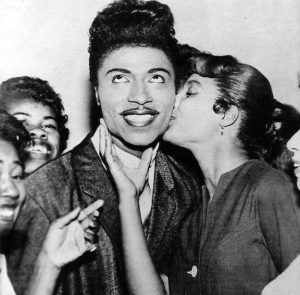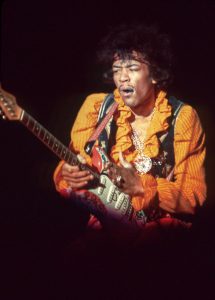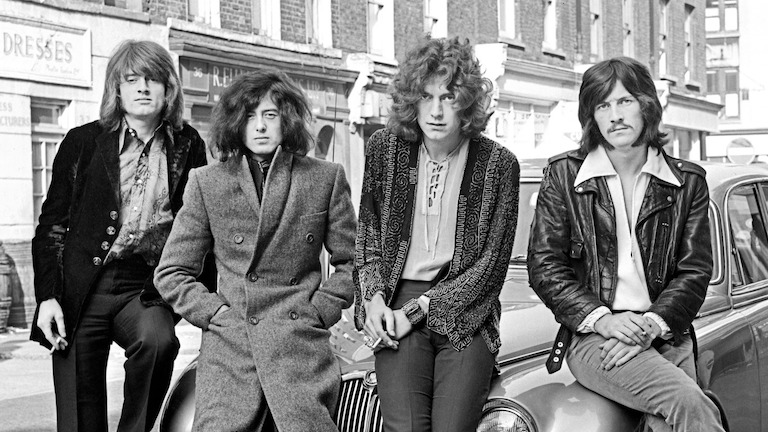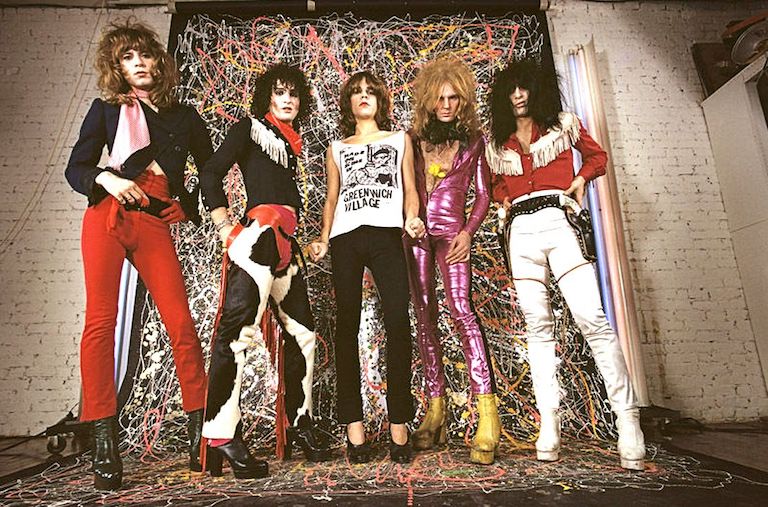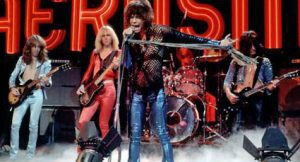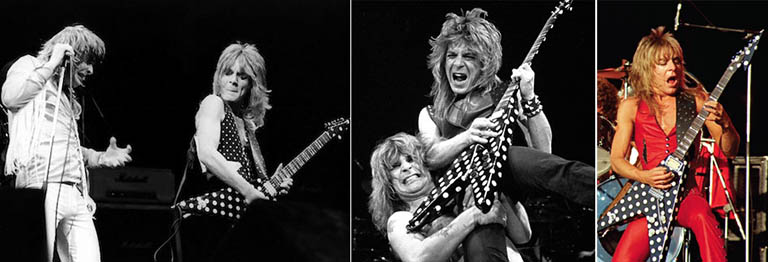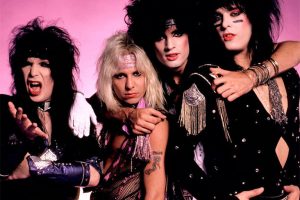Glam Rocks!
I was blessed to grow up in a home where my dad was (and remains) very musical, to the point where he taught guitar lessons when I was child. As my 1970s childhood was the zenith of the guitar rock era, there was always terrific music on the old turntable at home. In addition, this was the era of 1950s nostalgia — e.g. American Graffiti, Happy Days, Laverne & Shirley — so I was quickly exposed to all kinds of rock music going back to the beginning. I loved it all from the first backbeat and guitar solo, and I still do. (I even briefly took up bass guitar, before ultimately realizing that I had neither the talent nor the dedication to make it a career.)
Since the beginning of the rock ‘n’ roll era in the mid-1950s, the music itself has generally reflected a vigorous, almost violent style, initially symbolized by juvenile delinquents in ducktail haircuts and leather jackets. All the more amazing, therefore, to think that some of the greatest acts of the genre have been known for embracing softer, feminine images. Little Richard was perhaps the first (and arguably the best) example; his music retains a freshness and vitality even now, 70 years later. As you can see below, these female fans were certainly not put off in the least by a man embracing his feminine side!
Everyone is familiar with the massive impact of The Beatles, and when they first conquered North American airwaves in early 1964, their hair was considered effeminately long by their detractors and by most adults, who had come through the Depression and two World Wars and were obviously compelled by circumstances to grow up early. However, the thousands of screaming, swooning girls that attended their concerts and mobbed their public appearances (and several hundred million Beatles recordings sold to this day) made it quite clear that this was no impediment to success.
As rock progressed into the 1960s, the hair got much longer, and the clothes became increasingly flamboyant, even as the music itself simultaneously got much harder. The ultimate guitar hero was English-based former American paratrooper Jimi Hendrix, who made an iconic debut to American audiences at the 1967 Monterey Pop Festival. With his wild long hair, frilly clothes and psychedelically colored guitar, he single-handedly set new sonic and visual standards for the lead guitar role by playing one-handed (at times even no-handed), behind his back, while somersaulting — and then finished his set by literally lighting his guitar on fire, and smashing the remnants against the stage floor. The impact of this one performance on subsequent rock and roll acts is beyond calculation.
One of the most underrated British blues rock groups of this era was The Yardbirds, which featured three of England’s greatest guitarists in succession (Eric Clapton, Jeff Beck and Jimmy Page).
When they disbanded in 1968, Page formed Led Zeppelin, which was intended in many ways as a study in contrasts. Featuring lead singer Robert Plant and his long blond curls, high feminine voice and silk tops, raven-haired Page playing strong lead guitar, John Paul Jones laying down solid and steady bass lines, and John Bonham ferociously crushing his drum set, the band set the template for what would ultimately become known as heavy metal. Yet they were known for graceful songwriting, feminine appearance, mystical and introspective lyrics, musical technique and innovation, and great financial success — not to mention epic tales of debauchery with its many female fans and groupies.
The glam rock era began to unfold in earnest in the early 1970s, encouraged by the exuberantly flamboyant David Bowie, as well as by Marc Bolan of T. Rex. One of the prototypical punk rock groups was the all-male New York Dolls, who like The Yardbirds before them had much more influence than success. Their lead singer was David Johansen (aka Buster Poindexter of “Hot Hot Hot” fame in the 1980s), and the group’s visual style featured unmistakably female hairstyles, clothing and accessories, for which they were not easily categorized and paid a price when it came to public appeal and marketability, even in the permissive and indulgent 1970s. Over the long run, however, their influence as rock pioneers has become widely recognized. Their image also wielded a visual impact on the traditional hard rock acts of the time, including Aerosmith. (“Dude Looks Like a Lady”, indeed!)
Beginning with their 1978 debut, Van Halen led a very strong renewal of the hard rock scene. Lead singer David Lee Roth (sweeping blond mane and Spandex® attire) and guitarist Eddie Van Halen (slim build, teased hair and colorful stage clothes — RIP) were both known for telegenic and incendiary live performances, with drummer Alex Van Halen and bassist Michael Anthony laying down a quasi-martial rhythm section. With incredibly vigorous instrumentalism and vocals — not to mention the joyful humor on display in many of their greatest hits — their music remains captivating. And despite very soft features and appearance, Dave and Eddie were extremely popular with both male and female rockers, packing stadiums on their live tours from this era.
This affected more established acts like Ozzy Osbourne, who after leaving Black Sabbath teamed up with Randy Rhoads on guitar to record his 1980 solo debut Blizzard of Ozz, featuring well-known rock staples “Crazy Train” and the wonderfully self-deprecating “I Don’t Know”. In this era, Ozzy would perform in fringed, sequined tops — perhaps to contrast his bat-decapitating stage antics — while Randy (prior to his untimely death in 1982) played blistering solos with huge blond hair, high heeled boots, low-cut sleeveless vests, and skinny pants, yet was considered no less of a guitar hero for doing so. (And seriously, how cool is a polka dot Gibson Flying V?)
This reached full flower in the mid-1980s, when during the glory days of MTV it became necessary not just to sound cool, but to look cool. Michael Jackson and the Culture Club’s Boy George openly pushed this envelope from a pop perspective, to huge commercial, artistic and critical success. I recall as a junior high school student being totally mystified by the way the girls absolutely loved them both, and sincerely professing my utter incomprehension of this fact. (Meanwhile, at that age I had already set a well-established pattern of privately attempting to emulate my more stylish female classmates when it came to clothing and makeup.)
But the hard rock and metal acts of this period also embraced this style. Young British party animals Def Leppard exploded into the glorified realm of superstardom, appealing especially to female fans. There were also stateside glam metal groups like Mötley Crüe that combined hard sounds with a soft visual appearance. In addition, Ratt (slogan: “Fashion Rock”) experienced success with this approach — which seems only fitting, since their manager was Marshall Berle, nephew of Uncle Milty himself!
Surveying this rich history, one is struck by what appears to be a perfectly acceptable compatibility between feminine appearance and hyper-masculine musical performances. It’s almost as if these acts were collectively saying, “Our music speaks louder — literally and figuratively — than our image.” The self-confidence on display when they were in a recording studio or performing on stage is immediately evident and refreshing, in comparison to many of the manufactured pop acts of today (or in previous eras).
Perhaps these influences reinforced my own interest in rock music, my love of women’s fashion, and ultimately my willingness to step onto the public stage called Life and be willing to be measured by my performance, and not my image. Having come of age through a classically masculine path of organized sports, an IT career path, and other typically male hobbies and pursuits, it is so refreshing — indeed liberating — to be able to express publicly something I had always enjoyed privately, be respected by men and women alike, and serve others at the same time. (That said, I will always choose a sweater and leggings over metallic studs and leather pants!)
I would like to think I’m just like any other lady of my time and place, with my own individual tastes, interests and personality quirks. This classic metal chick is content to go without armor and rock on!
Category: Music


